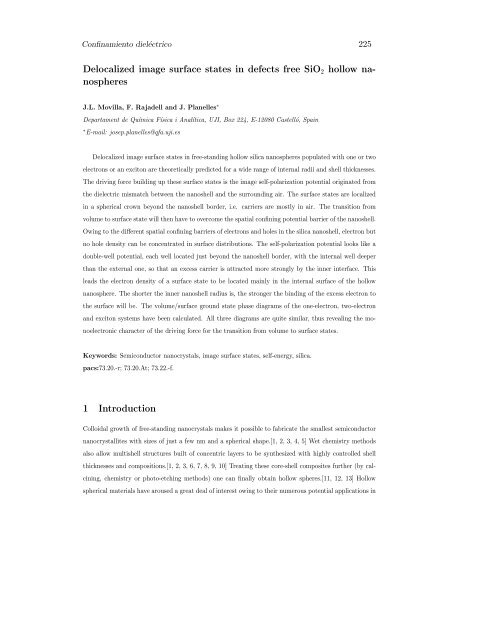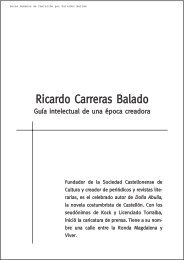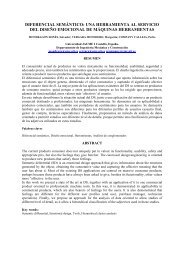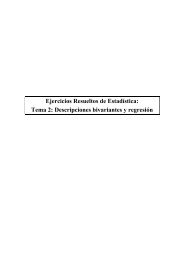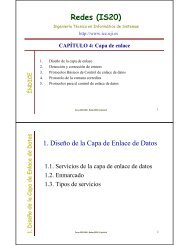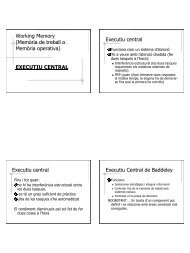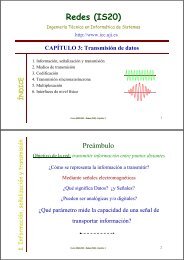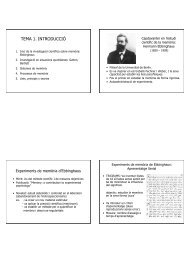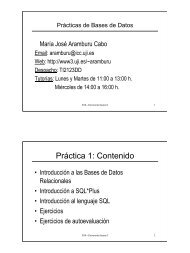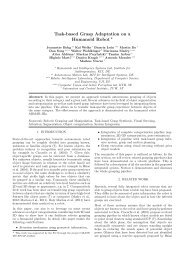224 PublicacionesJ. PLANELLES AND J. L. MOVILLA PHYSICAL REVIEW B 73, 235350 2006parameter t provides a straightforward way to ascertainwhether a specific nanoporous semiconductor material isable to induce electron trapping and, when this is the case, toobtain the largest radius of a trapping pore.Financial support from MEC-DGI Project No. CTQ2004-02315/BQU and UJI-Bancaixa Project No. P1-B2002-01Spain is gratefully acknowledged. A Spanish MECD FPUgrant is also acknowledged J.L.M..*Electronic address: josep.planelles@exp.uji.es1 K. Maex, M. R. Baklanov, D. Shamiryan, F. Iacopi, S. H. Brongersma,and Z. S. Yanovitskaya, J. Appl. Phys. 93, 8793 2003.2 H. Treichel and C. Goonetillake, Adv. Eng. Mater. 3, 461 2001.3 M. P. Petkov, Mater. Res. Soc. Symp. Proc. 731, W5.20 2002.4 K. Mosig, T. Jacobs, K. Brennan, M. Rasco, J. Wolf, and R.Augur, Microelectron. Eng. 64, 112002.5 S. Yu, T. K. S. Wong, and K. Pita, J. Vac. Sci. Technol. B 20,2036 2002.6 J. N. Bremmer, Solid State Technol. 44, S32001.7 L. Beji, B. Ismaïl, L. Sfaxi, F. Hassen, H. Maaref, and H. B.Ouada, J. Cryst. Growth 258, 842003.8 L. Bányai and S. W. Koch, Semiconductor Quantum Dots WorldScientific, Singapore, 1993.9 L. E. Brus, J. Chem. Phys. 80, 4403 1984.10 F. Stern, Phys. Rev. B 17, 5009 1978.11 P. G. Bolcatto and C. R. Proetto, J. Phys.: Condens. Matter 13,319 2001.12 M. Biasini, R. D. Gann, J. A. Yarmoff, A. P. Mills, L. N. Pfeiffer,K. W. West, X. P. A. Gao, and B. C. D. Williams, Appl. Phys.Lett. 86, 162111 2005.13 A. Orlandi, G. Goldoni, F. Mangui, and E. Molinari, Semicond.Sci. Technol. 17, 1302 2002.14 A. Orlandi, M. Rontani, G. Goldoni, F. Manghi, and E. Molinari,Phys. Rev. B 63, 045310 2001.15 J. L. Movilla, J. Planelles, and W. Jaskólski, Phys. Rev. B 73,035305 2006.16 J. L. Movilla and J. Planelles, Phys. Rev. B 71, 075319 2005.17 L. Bányai, P. Gilliot, Y. Z. Hu, and S. W. Koch, Phys. Rev. B 45,14136 1992.18 Z. Y. Deng, J. K. Guo, and T. R. Lai, J. Phys.: Condens. Matter 6,5949 1994.19 J. L. Movilla and J. Planelles, Comput. Phys. Commun. 170, 1442005.20 R. Tsu and D. Babić, Appl. Phys. Lett. 64, 1806 1994.21 M. Iwamatsu, M. Fujiwara, N. Happo, and K. Horii, J. Phys.:Condens. Matter 9, 9881 1997.22 M. Iwamatsu and K. Horii, Jpn. J. Appl. Phys., Part 1 36, 64161997.23 A. Franceschetti, A. Williamson, and A. Zunger, J. Phys. Chem.B 104, 3398 2000.24 See, e.g., B. O’Regan and M. Grätzel, Nature London 353, 7371991; R. Könenkamp, Phys. Rev. B 61, 11057 2000; N.Kopidakis,K. D. Benkstein, J. van de Lagemaat, A. J. Frank, Q.Yuan, and E. A. Schiff, ibid. 73, 045326 2006; E. A. Schiff,Sol. Energy Mater. Sol. Cells 78, 567 2003.25 R. A. Parker, Phys. Rev. 124, 1719 1961.26 M. Mikami, S. Nakamura, O. Kitao, and H. Arakawa, Phys. Rev.B 66, 155213 2002.27 J. Robertson, J. Vac. Sci. Technol. B 18, 1785 2000.28 Z. A. Weinberg, J. Appl. Phys. 53, 5052 1982.29 H. Tang, K. Prasad, R. Sanjinès, P. E. Schmid, and F. Lvy, J.Appl. Phys. 75, 2042 1994.30 B. Enright and D. Fitzmaurice, J. Phys. Chem. 100, 1027 1996.31 H. P. R. Frederikse, J. Appl. Phys. 32, 2211 1961.32 We should point out that the studied model, a spherical isolatedcavity in bulk, should be applied with caution to many currentporous materials used as electron carriers in dye-sensitized andhybrid organic/inorganic solar cells and other devices 24 as manyof them are porous materials with mesoscopic and nanoscopicbuilding blocks forming connected cavities and channels withcomplex geometries and, often, including impurities.33 We employ a cosinuslike dielectric profile in a 0.3 nm width interfaceseparating the two involved media. We have checkedhere that, as pointed out in Ref. 11, self-energy effects are insensitiveto the smoothing model and to interface widths of theorder of a lattice constant as that employed here.34 The depth of the self-polarization potential well is related to thedifference of the inverses of the permittivities involved in thedielectric mismatch, so that air-filled cavities are expected to bethe most favored situation for electron trapping. Thus, an R=2 nm air-filled pore in a semiconductor defined by m * =0.5,=10 can trap electrons overcoming a barrier height up to 2 eV.However, in the same conditions, we have calculated a barrier ofjust 0.6 eV if the pore is filled with a =1.78 material. Then, wecannot use Figs. 2 and 4 to determine trapping capability if thenanopore is filled with a medium other than air or a vacuum.35 <strong>It</strong> is worth to point out here that these results are limited to the Rvalues for which the effective mass and envelope function approximationsare applicable. For extremely small bubble radii itis expected that the reduced volume of the pores would yield alarge increase of the kinetic energy of the trapped electrons and,hence, a decrease of the pores trapping capacity in comparisonwith larger R values. However, within the framework of themodel employed here, this behavior holds for R values lowerthan 1 nm in all the studied cases, where we cannot trust theeffective mass and envelope function approximations any longerabout the range of applicability of EMA see, e.g., W. Jaskólskiand G. W. Bryant, Phys. Rev. B 57, R4237 1998; A.I. Ekimovet al., J. Opt. Soc. Am. B 10, 100 1993; D. J. Norris and M. G.Bawendi, Phys. Rev. B 53, 16338 1996.36 The employed effective mass m * =1 for TiO 2 may be found inRef. 29. However, much larger effective masses, e.g., m * =10Ref. 30 or m * =20 Ref. 31 have been also reported note thatthere are several forms of TiO 2 . <strong>It</strong> is known, in particular, that itstwo main forms, namely rutile and anatase, show differences indielectric constants and effective masses. A larger m * wouldyield a larger value for the parameter t, i.e., a larger trappingcapacity.235350-4
Confinamiento dieléctrico 225Delocalized image surface states in defects free SiO 2 hollow nanospheresJ.L. Movilla, F. Rajadell and J. Planelles ∗Departament de Química Física i Analítica, UJI, Box 224, E-12080 Castelló, Spain∗ E-mail: josep.planelles@qfa.uji.esDelocalized image surface states in free-standing hollow silica nanospheres populated with one or twoelectrons or an exciton are theoretically predicted for a wide range of internal radii and shell thicknesses.The driving force building up these surface states is the image self-polarization potential originated fromthe dielectric mismatch between the nanoshell and the surrounding air. The surface states are localizedin a spherical crown beyond the nanoshell border, i.e. carriers are mostly in air. The transition fromvolume to surface state will then have to overcome the spatial confining potential barrier of the nanoshell.Owing to the different spatial confining barriers of electrons and holes in the silica nanoshell, electron butno hole density can be concentrated in surface distributions. The self-polarization potential looks like adouble-well potential, each well located just beyond the nanoshell border, with the internal well deeperthan the external one, so that an excess carrier is attracted more strongly by the inner interface. Thisleads the electron density of a surface state to be located mainly in the internal surface of the hollownanosphere. The shorter the inner nanoshell radius is, the stronger the binding of the excess electron tothe surface will be. The volume/surface ground state phase diagrams of the one-electron, two-electronand exciton systems have been calculated. All three diagrams are quite similar, thus revealing the monoelectroniccharacter of the driving force for the transition from volume to surface states.Keywords: Semiconductor nanocrystals, image surface states, self-energy, silica.pacs:73.20.-r; 73.20.At; 73.22.-f.1 IntroductionColloidal growth of free-standing nanocrystals makes it possible to fabricate the smallest semiconductornanocrystallites with sizes of just a few nm and a spherical shape.[1, 2, 3, 4, 5] Wet chemistry methodsalso allow multishell structures built of concentric layers to be synthesized with highly controlled shellthicknesses and compositions.[1, 2, 3, 6, 7, 8, 9, 10] Treating these core-shell composites further (by calcining,chemistry or photo-etching methods) one can finally obtain hollow spheres.[11, 12, 13] Hollowspherical materials have aroused a great deal of interest owing to their numerous potential applications in
- Page 1:
CONFINAMIENTO NANOSCÓPICO ENESTRUC
- Page 5 and 6:
AgradecimientosDecía Albert Einste
- Page 7:
A mi madreA la memoria de mi padre
- Page 10 and 11:
viiihigh-correlation electronic reg
- Page 12 and 13:
xric) resolution method proves the
- Page 14 and 15:
xii14. F. Rajadell, J.L. Movilla, M
- Page 16 and 17:
xivcen para moldear a voluntad su e
- Page 18 and 19:
xvideterminar las características
- Page 23 and 24:
Capítulo 1Fundamentos teóricosEl
- Page 25 and 26:
1.1 Modelo k · p 3donde p = −i¯
- Page 27 and 28:
1.1 Modelo k · p 5inversa de la ma
- Page 29 and 30:
1.2 Heteroestructuras. Aproximació
- Page 31 and 32:
1.3 Masa efectiva dependiente de la
- Page 33 and 34:
1.4 Aplicación de un campo magnét
- Page 35 and 36:
1.5 Potenciales monopartícula adic
- Page 37 and 38:
1.6 Integración numérica del hami
- Page 39 and 40:
1.7 Transiciones intrabanda 17Tras
- Page 41 and 42:
1.7 Transiciones intrabanda 19g) [7
- Page 43 and 44:
Capítulo 2Confinamientos espacial
- Page 45 and 46:
23esta aproximación asume implíci
- Page 47 and 48:
2.1 Puntos cuánticos de InAs en ma
- Page 49 and 50:
2.1 Puntos cuánticos de InAs en ma
- Page 51 and 52:
2.1 Puntos cuánticos de InAs en ma
- Page 53 and 54:
2.1 Puntos cuánticos de InAs en ma
- Page 55 and 56:
Capítulo 3Confinamiento periódico
- Page 57 and 58:
3.1 Funciones de Wannier 35otro con
- Page 59 and 60:
3.1 Funciones de Wannier 373.1.1. F
- Page 61 and 62:
3.2 Evolución temporal en modelos
- Page 63 and 64:
3.2 Evolución temporal en modelos
- Page 65 and 66:
3.2 Evolución temporal en modelos
- Page 67 and 68:
3.3 Tiempo de tunneling en cadenas
- Page 69 and 70:
3.3 Tiempo de tunneling en cadenas
- Page 71 and 72:
Capítulo 4Confinamiento magnético
- Page 73 and 74:
51donde m ∗ es la masa efectiva d
- Page 75 and 76:
4.1 Magnetización de puntos y anil
- Page 77 and 78:
4.1 Magnetización de puntos y anil
- Page 79 and 80:
4.1 Magnetización de puntos y anil
- Page 81 and 82:
4.2 Acoplamiento lateral de anillos
- Page 83 and 84:
4.2 Acoplamiento lateral de anillos
- Page 85 and 86:
4.2 Acoplamiento lateral de anillos
- Page 87 and 88:
4.2 Acoplamiento lateral de anillos
- Page 89 and 90:
Capítulo 5Confinamiento dieléctri
- Page 91 and 92:
69Más complicado pero también ana
- Page 93 and 94:
5.1 Validez de la electrodinámica
- Page 95 and 96:
5.2 Interacciones culómbicas en pu
- Page 97 and 98:
5.2 Interacciones culómbicas en pu
- Page 99 and 100:
5.3 Barreras confinantes finitas e
- Page 101 and 102:
5.3 Barreras confinantes finitas e
- Page 103 and 104:
5.3 Barreras confinantes finitas e
- Page 105 and 106:
5.3 Barreras confinantes finitas e
- Page 107 and 108:
5.4 Impurezas dadoras hidrogenoides
- Page 109 and 110:
5.4 Impurezas dadoras hidrogenoides
- Page 111 and 112:
5.4 Impurezas dadoras hidrogenoides
- Page 113 and 114:
5.4 Impurezas dadoras hidrogenoides
- Page 115 and 116:
5.4 Impurezas dadoras hidrogenoides
- Page 117 and 118:
5.4 Impurezas dadoras hidrogenoides
- Page 119 and 120:
5.4 Impurezas dadoras hidrogenoides
- Page 121 and 122:
5.4 Impurezas dadoras hidrogenoides
- Page 123 and 124:
5.4 Impurezas dadoras hidrogenoides
- Page 125 and 126:
5.4 Impurezas dadoras hidrogenoides
- Page 127 and 128:
5.4 Impurezas dadoras hidrogenoides
- Page 129 and 130:
5.5 Estados superficiales inducidos
- Page 131 and 132:
5.5 Estados superficiales inducidos
- Page 133 and 134:
5.5 Estados superficiales inducidos
- Page 135 and 136:
5.5 Estados superficiales inducidos
- Page 137 and 138:
5.5 Estados superficiales inducidos
- Page 139 and 140:
5.5 Estados superficiales inducidos
- Page 141 and 142:
5.5 Estados superficiales inducidos
- Page 143 and 144:
5.5 Estados superficiales inducidos
- Page 145 and 146:
5.5 Estados superficiales inducidos
- Page 147 and 148:
5.5 Estados superficiales inducidos
- Page 149 and 150:
5.5 Estados superficiales inducidos
- Page 151 and 152:
5.5 Estados superficiales inducidos
- Page 153 and 154:
5.5 Estados superficiales inducidos
- Page 155 and 156:
5.5 Estados superficiales inducidos
- Page 157 and 158:
5.5 Estados superficiales inducidos
- Page 159 and 160:
5.5 Estados superficiales inducidos
- Page 161 and 162:
5.5 Estados superficiales inducidos
- Page 163 and 164:
5.5 Estados superficiales inducidos
- Page 165 and 166:
5.5 Estados superficiales inducidos
- Page 167 and 168:
5.5 Estados superficiales inducidos
- Page 169 and 170:
5.5 Estados superficiales inducidos
- Page 171 and 172:
5.5 Estados superficiales inducidos
- Page 173 and 174:
5.5 Estados superficiales inducidos
- Page 175 and 176:
Capítulo 6ConclusionesEn esta Tesi
- Page 177 and 178:
155entre los anillos como la orient
- Page 179 and 180:
157fuerte decaimiento de la intensi
- Page 181 and 182:
Publicaciones
- Page 183 and 184:
Confinamientos espacial y másico
- Page 185 and 186:
Confinamientos espacial y másico 1
- Page 187 and 188:
Confinamientos espacial y másico 1
- Page 189 and 190:
Confinamientos espacial y másico 1
- Page 191 and 192:
Confinamiento periódico
- Page 193 and 194:
Confinamiento periódico 171J. Phys
- Page 195 and 196: Confinamiento periódico 173Tunneli
- Page 197 and 198: Confinamiento periódico 175Tunneli
- Page 199 and 200: Confinamiento magnético
- Page 201 and 202: Confinamiento magnético 179Symmetr
- Page 203 and 204: Confinamiento magnético 181Aharono
- Page 205 and 206: Confinamiento magnético 183Aharono
- Page 207 and 208: Confinamiento magnético 185Aharono
- Page 209 and 210: Confinamiento magnético 187PHYSICA
- Page 211 and 212: Confinamiento magnético 189MAGNETI
- Page 213 and 214: Confinamiento magnético 191IOP Pub
- Page 215 and 216: Confinamiento magnético 193938Mean
- Page 217 and 218: Confinamiento magnético 195940QRs
- Page 219 and 220: Confinamiento dieléctrico
- Page 221 and 222: Confinamiento dieléctrico 199Compu
- Page 223 and 224: Confinamiento dieléctrico 201146 J
- Page 225 and 226: Confinamiento dieléctrico 203148 J
- Page 227 and 228: Confinamiento dieléctrico 205150 J
- Page 229 and 230: Confinamiento dieléctrico 207152 J
- Page 231 and 232: Confinamiento dieléctrico 209PHYSI
- Page 233 and 234: Confinamiento dieléctrico 211OFF-C
- Page 235 and 236: Confinamiento dieléctrico 213OFF-C
- Page 237 and 238: Confinamiento dieléctrico 215OFF-C
- Page 239 and 240: Confinamiento dieléctrico 217PHYSI
- Page 241 and 242: Confinamiento dieléctrico 219BRIEF
- Page 243 and 244: Confinamiento dieléctrico 221PHYSI
- Page 245: Confinamiento dieléctrico 223TRAPP
- Page 249 and 250: Confinamiento dieléctrico 227V s (
- Page 251 and 252: Confinamiento dieléctrico 229with
- Page 253 and 254: Confinamiento dieléctrico 231value
- Page 255 and 256: Confinamiento dieléctrico 233(R in
- Page 257 and 258: Confinamiento dieléctrico 23525R i
- Page 259 and 260: Confinamiento dieléctrico 237monoe
- Page 261 and 262: Confinamiento dieléctrico 239[8] Y
- Page 263 and 264: Confinamiento dieléctrico 241[48]
- Page 265 and 266: Confinamiento dieléctrico 243PHYSI
- Page 267 and 268: Confinamiento dieléctrico 245FROM
- Page 269 and 270: Confinamiento dieléctrico 247PHYSI
- Page 271 and 272: Confinamiento dieléctrico 249THEOR
- Page 273 and 274: Confinamiento dieléctrico 251THEOR
- Page 275 and 276: Confinamiento dieléctrico 253PHYSI
- Page 277 and 278: Confinamiento dieléctrico 255DIELE
- Page 279 and 280: Confinamiento dieléctrico 257DIELE
- Page 281 and 282: Confinamiento dieléctrico 259DIELE
- Page 283 and 284: Confinamiento dieléctrico 261DIELE
- Page 285 and 286: Confinamiento dieléctrico 263PHYSI
- Page 287 and 288: Confinamiento dieléctrico 265FAR-I
- Page 289 and 290: Confinamiento dieléctrico 267FAR-I
- Page 291 and 292: Confinamiento dieléctrico 269Diele
- Page 293 and 294: Confinamiento dieléctrico 271Diele
- Page 295 and 296: Confinamiento dieléctrico 273Diele
- Page 297 and 298:
Confinamiento dieléctrico 275Diele
- Page 299 and 300:
Confinamiento dieléctrico 277Diele
- Page 301 and 302:
Confinamiento dieléctrico 279Diele
- Page 303 and 304:
Confinamiento dieléctrico 281Diele
- Page 305 and 306:
Confinamiento dieléctrico 283Diele
- Page 307 and 308:
Confinamiento dieléctrico 285Diele
- Page 309 and 310:
Confinamiento dieléctrico 287Diele
- Page 311 and 312:
Confinamiento dieléctrico 289Diele
- Page 313 and 314:
Confinamiento dieléctrico 291Diele
- Page 315 and 316:
Bibliografía[1] J. Karwowski,“In
- Page 317 and 318:
BIBLIOGRAFÍA 295[23] J.L. Movilla,
- Page 319 and 320:
BIBLIOGRAFÍA 297[48] M.G. Burt,
- Page 321 and 322:
BIBLIOGRAFÍA 299[71] W.H. Press, S
- Page 323 and 324:
BIBLIOGRAFÍA 301[97] U.H. Lee, D.
- Page 325 and 326:
BIBLIOGRAFÍA 303[121] S.W. Chung,
- Page 327 and 328:
BIBLIOGRAFÍA 305[145] R. Blossey y
- Page 329 and 330:
BIBLIOGRAFÍA 307[169] F. Suárez,
- Page 331 and 332:
BIBLIOGRAFÍA 309[194] C. Delerue,
- Page 333 and 334:
BIBLIOGRAFÍA 311[220] J.L. Zhu y X
- Page 335 and 336:
BIBLIOGRAFÍA 313[245] L.M. Peter,
- Page 337 and 338:
BIBLIOGRAFÍA 315[266] P. Rinke, K.
- Page 339 and 340:
BIBLIOGRAFÍA 317[289] Y. Wang, L.
- Page 341 and 342:
BIBLIOGRAFÍA 319[314] A. Wójs y P


